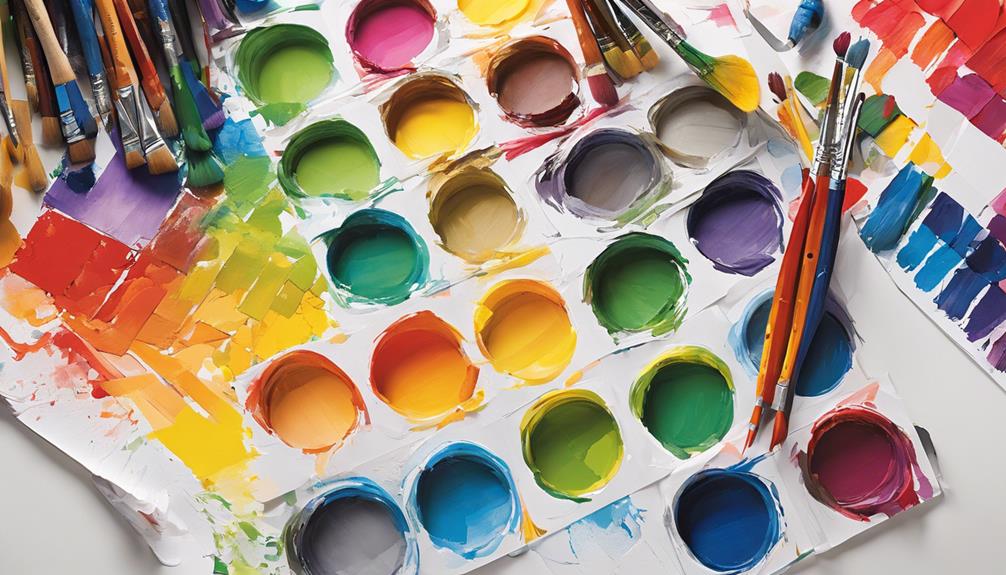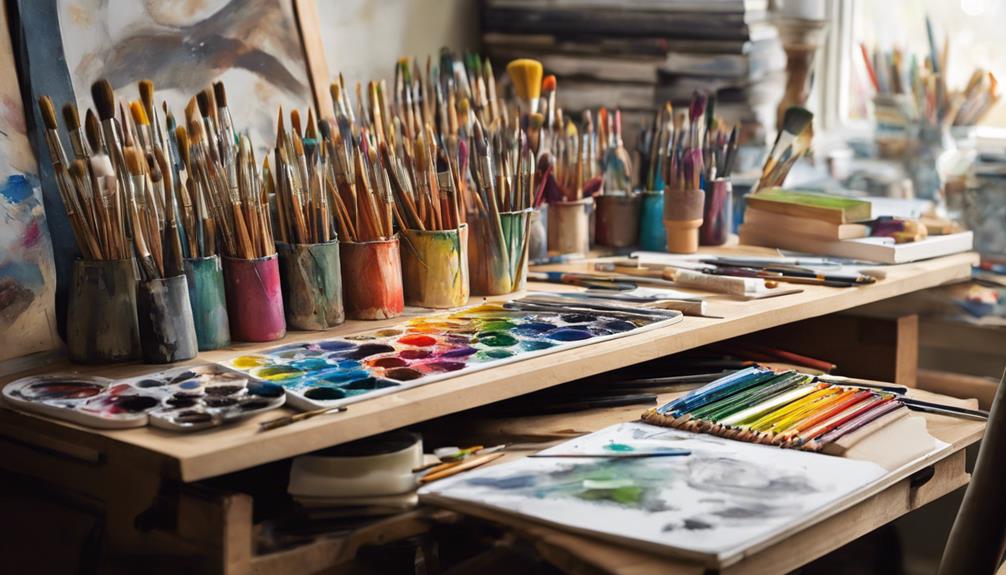To excel in art through learning with lesson plans, it is important to establish clear objectives for each lesson. Ensure that your goals are SMART: specific, measurable, achievable, relevant, and time-bound. Customize your lessons based on skill levels by modifying complexity and materials. Begin with dynamic warm-up activities such as brief drawing exercises. Keep motivation high with attainable goals and positive reinforcement. Engage actively in art tasks to boost creativity. By adhering to these guidelines, you can unlock your creative abilities and thrive in the art world. Further methods to improve your artistic skills are also available.
Key Takeaways
- Set SMART objectives in lesson plans to track progress and foster student success.
- Tailor lessons to individual skill levels for effective challenge and support.
- Engage students with dynamic warm-up activities to stimulate creativity.
- Provide motivation through achievable goals and positive reinforcement.
- Foster creativity by encouraging active participation and exploration of various mediums and techniques.
Setting Clear Goals for Lessons
In art education, establishing clear goals is vital for guiding instruction and fostering student success. When creating an art lesson plan, it's essential to outline specific objectives that Art Students can understand and work towards achieving. These goals should be SMART – specific, measurable, achievable, relevant, and time-bound. By setting clear goals in our lesson planning, we provide direction not only for the students but also for educators like us.
Art Students benefit greatly from having a roadmap of what they're expected to learn and accomplish in each lesson. Clear goals help track progress, assess learning outcomes, and adjust teaching methods as needed to guarantee student understanding. Additionally, establishing clear goals fosters accountability, motivation, and a sense of accomplishment among students. Through thoughtfully crafted art lesson plans, we can empower our students to reach their full creative potential and succeed in their artistic endeavors.
Tailoring Lessons to Skill Levels

Tailoring art lessons to different skill levels involves adapting project complexity, materials, and guidance to cater to individual needs effectively. When teaching art, it's important to take into account the diverse skills and experiences of students to create a supportive learning environment. By providing tailored lessons, educators can make sure that each student feels challenged yet capable of success. Here's a table outlining how lessons can be customized to different skill levels:
| Skill Level | Project Complexity | Materials |
|---|---|---|
| Beginner | Simple projects with clear steps | Basic art supplies |
| Intermediate | Projects with room for creativity | Variety of mediums |
| Advanced | Complex projects for skill growth | Specialized tools and materials |
| All Levels | Options for customization | Accessible to all students |
| All Levels | Encouragement and feedback | Peer collaboration |
Engaging Warm-Up Activities
Let's kickstart our art lessons with dynamic warm-up activities that ignite creativity and captivate students' interest from the get-go. Engaging warm-up activities are essential in preparing students for the art lesson ahead.
Here are three exciting warm-up activities to incorporate into your art class:
- Quick drawing exercises: Encourage students to sketch a simple object or scene within a time limit to get their creative juices flowing.
- Color mixing challenges: Have students experiment with mixing primary colors to create secondary colors, fostering exploration and understanding of color theory.
- Visual scavenger hunts: Send students on a quest to find specific shapes, colors, or textures in their surroundings, encouraging observation and attention to detail.
Providing Motivation and Encouragement

As we guide students through their artistic journey, our focus shifts towards nurturing motivation and providing encouragement for their growth and exploration in art. In Teaching Art, motivation can be cultivated by helping learners set achievable goals and offering positive reinforcement along the way.
Recognizing small milestones achieved during art lessons can fuel students' determination and enthusiasm to progress further. Encouragement plays a vital role in building confidence and inspiring learners to embrace new artistic challenges with enthusiasm.
By offering constructive feedback and unwavering support, educators can assist students in overcoming obstacles and staying committed to their artistic development. Creating a supportive and inclusive environment within the art classroom can foster a sense of belonging and empower learners to push their boundaries, master new skills, and express their creativity with confidence.
Fostering Creativity Through Participation
Active engagement in art lessons ignites creativity by encouraging us to explore various mediums, techniques, and styles.
We should welcome experimentation and exploration to cultivate diverse artistic expressions.
Through participating in hands-on activities, we can unveil our imagination and express ourselves confidently.
Active Engagement Sparks Creativity
Engaging in hands-on art activities ignites creativity by encouraging students to freely explore and express their ideas. Active engagement in art lessons enhances creativity as students create, experiment, and problem-solve. Participation in artistic endeavors allows individuals to develop critical thinking skills while honing their artistic abilities.
Involvement in art projects fosters a sense of ownership and pride in the creative process. Actively engaging in art activities promotes self-expression, confidence, and a deeper connection to the artistic world. Encouraging students to actively participate in art lessons helps them discover and nurture their unique artistic voice, leading to personal growth and artistic development.
Encourage Diverse Artistic Expressions
Exploring diverse artistic expressions in art lessons encourages students to embrace their individuality and unleash their creativity through active participation and experimentation. By promoting diverse artistic expressions, students can experience artistic growth and develop their unique styles.
Providing opportunities for experimentation with various mediums and techniques allows students to explore their creativity freely. Emphasizing the importance of trying new approaches and taking risks in art projects helps students discover their artistic potential.
Celebrating different perspectives and approaches in art creates a supportive environment where students feel valued for their creativity. Through diverse artistic expressions and experimentation, students can tap into their creative abilities and gain confidence in their artistic skills.
Embrace Experimentation and Exploration
Embracing experimentation and exploration in art allows us to cultivate our creativity and express ourselves authentically. When we step out of our comfort zones and try new techniques, we open doors to endless possibilities in our artistic journey.
Here are three ways to embrace experimentation and exploration in art:
- Try mixing different mediums: Combine paints, pencils, or digital tools to create unique textures and effects.
- Explore unconventional subjects: Look beyond the ordinary and draw inspiration from nature, emotions, or abstract concepts.
- Play with perspective and composition: Experiment with different angles, lighting, and arrangements to add depth and interest to your artwork.
Supporting Student Confidence and Experimentation

Supporting student confidence in art leads to a greater willingness to experiment and explore creatively. When students feel secure in their abilities, they're more likely to step out of their comfort zones and try new art skills.
Confidence is like a springboard, propelling them towards experimentation and pushing the boundaries of their artistic abilities. By fostering a supportive environment that values each student's unique creative journey, educators can empower their students to take risks and embrace new challenges in their artwork.
Encouraging confidence also means allowing room for mistakes and viewing them as opportunities for growth rather than failures. This resilience-building approach not only enhances artistic skills but also boosts self-esteem and motivation.
As students gain confidence in their abilities, they're more willing to explore different techniques, styles, and ideas, ultimately developing their artistic voice. Creating a safe space for expression where students feel supported and encouraged is key to nurturing their confidence and fostering a spirit of experimentation in art.
Developing Artistic Content Based on Interests

Tailoring art lessons to match our interests allows us to explore what excites us most and sparks our creativity.
By focusing on topics that captivate us personally, we can generate fresh and unique ideas for our artistic projects.
Understanding and embracing our passions in art can lead to a more engaging and fulfilling learning experience.
Explore Personal Interests
Exploring personal interests is key to developing unique and engaging artistic content in lesson plans. When aligning art projects with personal preferences, such as favorite colors, themes, or styles, students feel more connected to their work. Tailoring lessons to integrate hobbies and passions fosters self-expression, making the artistic experience more meaningful.
By encouraging students to infuse their personal interests into their artwork, they can create pieces that aren't only unique but also deeply personalized. This approach helps students stay motivated and invested in their creative learning journey.
To make the most of this process, consider the following:
- Identify personal interests and hobbies as a starting point for art projects.
- Tailor lessons to align with individual preferences, like favorite colors or themes.
- Use hobbies and passions as inspiration for creating personalized artwork.
Generate Unique Ideas
In developing unique artistic content based on interests, we prioritize engaging students through personalized and relevant lesson plans. By incorporating students' passions and experiences into the lesson ideas, we can inspire creativity and foster a deeper connection to the subject matter. This approach not only enhances engagement but also encourages students to express themselves in meaningful ways that resonate with their personal experiences. For example, using **valentine’s day card inspiration** can serve as a creative outlet, allowing students to design and craft heartfelt messages while learning about artistic techniques. By connecting lessons to real-life occasions and interests, we help students build lasting skills that feel relevant and rewarding.
When we plan art lessons, we focus on using design principles and composition techniques to guide students in creating meaningful and visually appealing artwork. Additionally, encouraging observational drawing helps students develop their skills in capturing details and honing their artistic abilities.
Providing constructive feedback on finished work not only reinforces learning concepts but also opens up opportunities for discussion and growth. By connecting art lessons to significant artworks from diverse cultures, we broaden students' understanding and appreciation of art, enriching their artistic journey.
Encouraging Creativity Within Limits

Encouraging students to nurture their creativity within set boundaries is a key strategy in fostering innovative thinking in art education. By providing guidelines and structure in art instruction, creativity can flourish while helping students develop essential skills.
- Promoting Problem-Solving Skills: Encouraging students to explore different solutions within defined parameters challenges them to think critically and find creative ways to overcome obstacles.
- Focusing Creativity Towards Specific Goals: Setting boundaries helps students channel their creative energy towards achieving specific artistic outcomes, teaching them the importance of intentionality in their work.
- Balancing Freedom and Discipline: By balancing freedom of expression with the discipline of following guidelines, students learn to express themselves effectively within constraints, enhancing their ability to communicate through their art.
Reflecting on Teaching Experiences

Reflecting on our teaching experiences is an important practice that allows us to assess and enhance the effectiveness of our art instruction. When we take the time to teach, it's vital to reflect on how our students finish their projects and the concepts they've learned. By analyzing our teaching experiences, we can identify what worked well and where improvements are needed. This reflection helps us understand student engagement, comprehension, and progress in the learning process.
Through this process, we gain valuable insights into the effectiveness of our instructional strategies and delivery methods. It also provides us with a better understanding of the assessment techniques and student feedback mechanisms that are most beneficial. By reflecting on our teaching experiences, we continuously improve and enhance the quality of art education we provide. This reflective practice is a cornerstone of effective teaching, guiding us towards better serving our students and fostering a deeper appreciation for the arts.
Assessing Student Needs and Seeking Feedback

Evaluating student needs is essential for customizing our teaching approach effectively.
We use formative evaluations to measure understanding and adjust methods accordingly.
Seeking feedback from students helps us understand their preferences and areas for improvement.
Student Needs Assessment
After gathering feedback through surveys and interviews, we can tailor our art lessons to meet the diverse needs of our students effectively. Understanding student needs is essential for creating engaging and meaningful lessons.
Here are three key ways to assess student needs and enhance lesson plans:
- Utilize diagnostic assessments to identify individual strengths and areas for improvement.
- Collaborate with colleagues and parents to gain insights into students' social and emotional needs related to art education.
- Analyze student work and responses to art activities to customize lessons for diverse learning styles.
Seeking Input From Students
Let's gather valuable insights by actively engaging students in discussions and feedback sessions to better understand their needs and preferences for art education. As an art teacher, it's essential to assess students' skills by observing their participation, comprehension, and any challenges they face during lessons.
Seeking feedback directly from students through verbal conversations, written reflections, or surveys can provide valuable information on what's working well and where adjustments may be needed. By incorporating student feedback into lesson planning, such as asking for input on topics they find interesting or preferred learning activities, teachers can tailor their approach to better meet individual student needs.
Regular check-ins with students ensure their feedback is valued and implemented, fostering a collaborative and supportive learning environment.
Feedback Collection Methods
We gather valuable insights from students through various methods like surveys, interviews, and reflection journals to understand their needs and preferences in art education. When it comes to collecting feedback effectively, it's crucial to use a combination of strategies to gain a comprehensive view of student experiences.
Here are three key methods we employ:
- Surveys: By using surveys, we can gather quantitative data on student opinions and preferences.
- Conversations: One-on-one conversations allow us to explore further into individual feedback, understanding specific needs and concerns.
- Exit Tickets: These immediate feedback tools help us assess student learning right after a lesson, providing valuable insights for future improvements.
These methods ensure that we continuously adjust our teaching approaches to better serve our students' educational needs.
Frequently Asked Questions
How Do You Develop Mastery in a Lesson Plan?
We develop mastery in a lesson plan through aligning standards, incorporating clear assessment criteria, realistic timelines, innovative teaching strategies, and diverse art mediums. Reflection, adaptation to student needs, and integrating art across subjects are crucial for mastery.
How Do You Master Lesson Planning?
We master lesson planning by setting clear objectives, designing engaging activities, and using effective assessments. We seek feedback, reflect on experiences, and continuously improve our skills. Staying organized with a master copy guarantees easy access and future enhancements.
How Can I Improve My Art Lessons?
We enhance art lessons by infusing creativity, utilizing diverse teaching methods, and structuring engaging activities. Assessment tools track progress effectively. Our approach considers student needs, timelines, and innovative strategies for an enriched learning experience.
How Do You Plan an Art Lesson Plan?
We plan art lessons by outlining objectives, aligning with standards, incorporating engaging elements, setting a realistic timeline, and including clear assessments. Assessment informs future teaching. Criteria are communicated to students. Our lesson plans foster learning and creativity.
Conclusion
In summary, mastering art through lesson plans requires setting clear goals and tailoring lessons to skill levels.
It's important to engage in warm-up activities, provide motivation and encouragement, and foster creativity through participation.
Developing artistic content based on interests and encouraging creativity within limits are also vital.
Reflecting on teaching experiences, evaluating student needs, and seeking feedback are key components to improving art skills.
According to a recent study, students who engage in structured art lessons show a 30% increase in creativity and artistic abilities.









